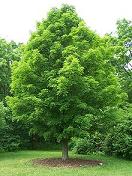April 15, 2010
Why Is There So Much Pollen?

I'm bored and horny, which are the same thing
Female trees are not sought after by landscapers (especially in the city) because what makes them pretty-- flowers and fruit-- also makes them considerably high maintenance. Someone has to clean up after them.
So urban landscapers favor male trees-- no flowers. But plenty of pollen.
There are things which complicate allergies in the city.
First is the urban environment: it's concrete and limited. There's nowhere to go, nothing to do, except blow around aimlessly.
Second, because of the cars, etc, there's plenty of carbon dioxide-- essentially fast food for trees-- which makes the trees pollinate even more.
Third-- and if you don't live near a city all you need to do is watch any TV show set in a city-- Grey's Anatomy or CSI NY-- there aren't that many different kinds of trees. The same types are used over and over. People forget that there are millions of kinds of trees, they expect to see the same 5 or so.
Unlike delicious rum, exposure to the same kinds of pollen over and over makes you more sensitive to it, not less. Certainly if there were more species of tree out there, you wouldn't react as negatively to a repeated presentation of the same kind. But, as said, female trees are deliberately avoided by landscapers. Since you're not used to seeing different kinds of trees, it never quite hits you that this state of affairs is not only unnecessary, it's deliberately manufactured.
But most importantly to the problem of pollination is simply that there aren't any female trees. This makes the male trees pollinate more. Ordinarily, a paucity of female trees would result in a shift in equilibrium, to form more females/less males.
But the landscape isn't natural, it's artificial-- no female trees. So the male trees, instinctively, keep upping their game; they're not aware they're doing it, of course. Nor are they aware that it doesn't make a difference what they do-- because the environment is being manipulated from the outside.
II.
Imagine what kind of upkeep would be necessary if, for some reason, we didn't have any male trees. How much would it cost the city to both remove the male trees while maintaining the female trees, the seeds, etc? Putting aside environmental concerns, trying to keep up this kind of disequilibrium wouldn't make any economic sense. We'd quite quickly figure out a way to plant some male trees.
III.
Or, this.
17 Comments